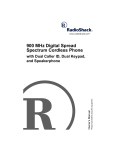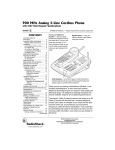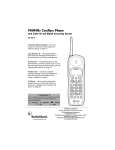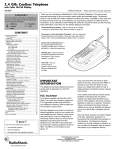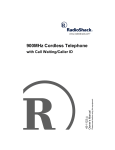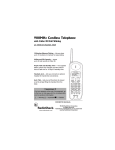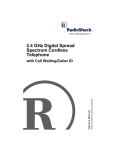Download Radio Shack 900 MHz Digital Spread Spectrum Cordless Phone with Digital Answerer and Caller ID/Call Waiting Deluxe Cordless Telephone User Manual
Transcript
900 MHz Digital Spread
Spectrum Cordless Phone
Please read before using this equipment.
Owner’s Manual
with Digital Answerer and Caller
ID/Call Waiting Deluxe
ˆ Read This Before Installation
We have designed your phone to conform to
federal regulations, and you can connect it to
most telephone lines. However, each device
you connect to the telephone line draws
power from the telephone line. We refer to
this power draw as the device's ringer equivalence number, or REN on the bottom of
your phone.
WARNING: To reduce the risk of fire or
shock hazard, do not expose this product to rain
or moisture.
CAUTION
RISK OF ELECTRIC SHOCK.
DO NOT OPEN.
!
CAUTION: TO REDUCE THE RISK OF
If you use more than one phone or other device on the line, add up all of the RENs. If the
total is more than five (three in rural areas),
your telephones might not ring. If ringer operation is impaired, remove a device from the
line.
Important: Cordless phones such as this
one require AC power to operate. When the
AC power is off, you cannot dial out or receive incoming calls using your cordless
phone. For this reason, a cordless phone
should not be your only telephone. To be
safe, you should also have a phone that
does not require AC power to operate (not a
cordless phone) so you can still make and
receive calls if there is an AC power failure.
Some cordless phones operate at frequencies that might cause interference to nearby
TVs and VCRs. To minimize or prevent such
interference, the base of the cordless phone
should not be placed near or on top of a TV
or VCR.
Your telephone operates on standard radio
frequencies as allocated by the FCC. Even
though the access protection code prevents
unauthorized use of your phone line, it is
possible for other radio units operating on
similar frequencies within a certain area to
unintentionally intercept your conversations
and/or cause interference. This lack of privacy can occur with any cordless phone.
ELECTRIC SHOCK, DO NOT REMOVE
COVER OR BACK. NO USER-SERVICEABLE PARTS INSIDE. REFER SERVICING
TO QUALIFIED PERSONNEL.
This symbol is intended to alert
you to the presence of uninsulated dangerous voltage within
the product’s enclosure that might
be of sufficient magnitude to constitute a risk of electric shock. Do
not open the product’s case.
!
This symbol is intended to inform
you that important operating and
maintenance instructions are
included in the literature accompanying this product.
FCC STATEMENT
Your phone complies with Part 68 of FCC
Rules. You must, upon request, provide the
FCC registration number and the REN to
your telephone company. Both numbers are
the bottom of your phone.
Note: You must not connect your phone to:
• coin-operated systems
• party-line systems
• most electronic key telephone systems
© 2001 RadioShack Corporation.
All Rights Reserved.
RadioShack and RadioShack.com are trademarks used by RadioShack Corporation.
2
Read This Before Installation
In the unlikely event that your phone causes
problems on the phone line, the phone company can temporarily discontinue your service. If this happens, the phone company
attempts to notify you in advance. If advance
notice is not practical, the phone company
notifies you as soon as possible and advises
you of your right to file a complaint with the
FCC.
Also, the phone company can make changes
to its lines, equipment, operations, or procedures that could affect the operation of this
telephone. The telephone company notifies
you of these changes in advance, so you can
take the necessary steps to prevent interruption of your telephone service.
• caller’s name and number
IMPORTANT SAFETY
INSTRUCTIONS
When using your telephone equipment, basic safety precautions should always be followed to reduce the risk of fire, electric
shock, and injury to persons, including the
following:
1. Read and understand all instructions.
2. Follow all warnings and instructions
marked on the product.
3. Never install telephone wiring during a
lightning storm.
Lightning
Your telephone has built-in protection circuits
to reduce the risk of damage from surges in
telephone line and power line current. These
protection circuits meet or exceed the FCC
requirements. However, lightning striking the
telephone or power lines can damage your
telephone.
Lightning damage is not common. Nevertheless, if you live in an area that has severe
electrical storms, we suggest that you unplug
your phone when storms approach to reduce
the possibility of damage.
IMPORTANT CALLER ID
INFORMATION
To use the system’s Caller ID and Call Waiting features, you must be in an area where
those services are available and you must
subscribe to those services through your local phone company.
Where Caller ID is offered, one or more options are generally available:
• caller’s number only
• caller’s name only
4. Never install telephone jacks in wet
locations unless the jack is specifically
designed for wet locations.
5. Never touch uninstalled telephone wires
or terminals unless the telephone line
has been disconnected at the network
interface.
6. Use caution when installing or modifying
telephone lines.
7. Do not attach the AC power supply cord
to building surfaces with metal fittings (if
the product has an AC power cord).
8. Unplug this product from the wall outlet
before cleaning. Do not use liquid cleaners or aerosol cleaners. Use a damp
cloth for cleaning.
9. Do not use this product near water, for
example, near a bathtub, wash bowl,
kitchen sink, aquarium, or laundry tub, in
a wet basement, or near a swimming
pool.
10. Do not place this product on an unstable
cart, stand, or table. The product may
Read This Before Installation
3
fall, causing serious damage to the
product.
11. Slots and openings in the cabinet and
the back or bottom are provided for ventilation. To protect the product from overheating, these openings must not be
blocked or covered. The openings
should never be blocked by placing the
product on a bed, sofa, rug, or other
similar surface. This product should not
be placed in a built-in installation unless
proper ventilation is provided.
12. This product should never be placed
near or over a radiator or heat register.
13. This product should be operated only
from the type of power source indicated
on the marking label. If you are not sure
of the type of power supply to your
home, consult your local power company.
14. Do not allow anything to rest on the
power cord. Do not locate this product
where the cord will be stepped on.
15. Do not overload wall outlets and extension cords as this can result in a risk of
fire or electric shock.
16. Never push objects of any kind into this
product through cabinet slots as they
may touch dangerous voltage points or
short out parts that could result in a risk
of fire or electric shock. Never spill liquid
of any kind on the product.
17. To reduce the risk of electric shock, do
not disassemble this product. Take it to
a qualified serviceman when service or
repair work is required. Opening or
removing covers may expose you to
dangerous voltage or other risks. Incorrect reassembly can cause electric
shock when the product is subsequently
used.
4
18. Unplug this product from the wall outlet
and refer servicing to qualified service
personnel under the following conditions:
• When the power cord plug is damaged or frayed.
• If liquid has been spilled into the
product.
• If the product has been exposed to
rain or water.
• If the product does not operate normally by following the operating
instructions. Adjust only those controls that are covered by the operating instructions because improper
adjustment of other controls may
result in damage and will often
require extensive work by a qualified
technician to restore the product to
normal operation.
• If the product has been dropped or
the cabinet has been damaged.
• If the product exhibits a distinct
change in performance.
19. Avoid using a telephone (other than a
cordless type) during an electrical storm.
There may be a remote risk of electric
shock from lightning.
20. Do not use the telephone to report a gas
leak in the vicinity of the leak.
BATTERY SAFETY
INSTRUCTIONS
Caution: To reduce the risk of fire or injury,
read and follow these instructions.
1. Use only the appropriate type and size
battery pack specified in the instruction
manual provided for this product.
Read This Before Installation
2. Do not dispose of the battery pack in a
fire. The cell may explode. Check with
local codes for possible special disposal
instructions.
3. Do not open or mutilate the battery
pack. Released electrolyte is corrosive
and may cause damage to the eyes or
skin. It may be toxic if swallowed.
4. Exercise care in handling the battery
pack in order not to short it with conducting materials such as rings, bracelets,
and keys. The battery or conductor may
overheat and cause burns.
5. Charge the battery pack provided with or
identified for use with this product only in
accordance with the instructions and
limitations specified in the instruction
manual provided for this product.
6. Observe proper polarity orientation
between the battery pack and battery
charger.
SAVE THESE
INSTRUCTIONS
Read This Before Installation
5
ˆ Contents
Features .................................................................................................................................. 8
Installation .............................................................................................................................. 9
Choosing a Location ............................................................................................................ 9
Mounting the System ........................................................................................................... 9
On a Desk ........................................................................................................................ 9
On a Wall Plate ................................................................................................................ 9
On a Wall ....................................................................................................................... 10
Connecting, Charging, and Replacing the Battery Pack .................................................... 10
Setting the Dialing Mode .................................................................................................... 11
Setting the Handset’s Ringer Tone/Volume ....................................................................... 12
Turning the Base’s Ringer On/Off ...................................................................................... 12
Setting Auto Talk ................................................................................................................ 12
Turning Caller ID/Call Waiting On/Off ................................................................................ 13
Storing Your Area Code ..................................................................................................... 13
Telephone Operation ............................................................................................................ 14
A Quick Look at the Handset ............................................................................................. 14
A Quick Look at the Base .................................................................................................. 15
Switching Between the Handset and the Speakerphone ................................................... 16
Using Both the Handset and the Speakerphone ................................................................ 16
Using a Headset ................................................................................................................ 16
Memory Dialing .................................................................................................................. 16
Storing a Name and Number in Memory ....................................................................... 16
Editing or Deleting a Number in Memory ....................................................................... 17
Entering a Pause ........................................................................................................... 18
Reviewing Memory Numbers ........................................................................................ 18
Dialing a Memory Number ............................................................................................. 18
Chain-Dialing Service Numbers .................................................................................... 18
Testing Stored Emergency Numbers ............................................................................. 18
Caller ID Operation ...............................................................................................................
Call Waiting Options Service ..............................................................................................
Using Call Waiting Options ............................................................................................
Using Ask to Hold ..........................................................................................................
Using Conference ..........................................................................................................
Reviewing Caller ID Records .............................................................................................
Caller ID Messages .......................................................................................................
Adding/Deleting the Area Code .........................................................................................
Dialing Numbers from Caller ID Records ...........................................................................
Storing a Caller ID Number in Memory ..............................................................................
Deleting Caller ID Records ................................................................................................
19
19
19
20
20
20
21
21
21
21
21
Answering System Operation .............................................................................................
Using the Menu Button ......................................................................................................
Setting the Day and Time ...................................................................................................
Setting the Number of Rings ..............................................................................................
23
23
23
23
6
Contents
Setting the Record Time ....................................................................................................
Selecting the Outgoing Message ......................................................................................
Recording/Deleting an Outgoing Message ...................................................................
Setting the TAD to Answer Calls .......................................................................................
Screening Calls .................................................................................................................
Recording Incoming Messages .........................................................................................
Using the Mail Boxes .........................................................................................................
Recording a Memo ............................................................................................................
Recording a Conversation .................................................................................................
Playing Messages .............................................................................................................
Adjusting the TAD’s Volume ..............................................................................................
Deleting Messages ............................................................................................................
Remote Operation .............................................................................................................
Setting the Security Code .............................................................................................
Using the Toll-Saver ......................................................................................................
Using Remote Commands ............................................................................................
Playing Back the Messages ..........................................................................................
Deleting All the Messages in a Mail Box .......................................................................
Setting the TAD to Answer Calls ...................................................................................
Setting the TAD Not to Answer Calls ............................................................................
Recording a Memo ........................................................................................................
Recording a New Outgoing Message ...........................................................................
Listening to the Help Guide ...........................................................................................
24
24
24
25
25
25
25
26
26
26
27
27
27
27
27
28
28
28
29
29
29
29
29
Troubleshooting ................................................................................................................... 30
Care ................................................................................................................................... 31
Contents
7
ˆ Features
Your RadioShack 900 MHz Digital Spread
Spectrum Cordless Phone uses advanced
technology for superior audio quality and extended range. Caller ID records each caller’s
telephone number (and name, if available in
your area) and the date and time of the call,
as provided by your local phone company to
Caller ID service subscribers.
If you subscribe to Call Waiting and Caller
ID, the phone can show you the incoming
caller information, even when you are already talking on the phone.
Any-Key Answer — you can set the phone
so you can press any key to answer a call
when the handset is away from the base.
Hearing-Aid Compatibility — lets you use
your phone with hearing aids that have a T
(telephone) switch.
The Telephone Answering Device (TAD)
stores up to 20 minutes of messages on a
computer chip and records each message’s
day and time. This gives you advanced capabilities over tape-based answering machines:
The phone’s features include:
• You can delete individual messages and
save the rest.
Spread Spectrum Technology — spreads
the signal across several frequencies, providing additional security for your phone conversations.
• There are no tapes to bother with and no
tape mechanisms to wear out.
Caller ID/Call Waiting Deluxe — gives you
several options for handling waiting callers
(you must subscribe to the Call Waiting Options Service through your phone company
to use this feature).
The remote operation feature lets you operate your TAD from a touch-tone phone or
from a rotary phone with a pocket tone dialer.
20 Number Memory Dialing — lets you
store up to 20 numbers in memory for easy
dialing.
Phone Pick-Up Detection — stops recording when you pick up any phone on the same
line as the TAD, and resets to answer the
next call.
Headset Jack — for optional hands-free use
with a headset (available at your local
RadioShack store).
The TAD’s features include:
Voice-Prompted Menu Setting — lets you
set the TAD’s various functions through the
voice guidance.
Security Access-Protection Code — helps
prevent other cordless phone users from using your phone line while the handset is off
the base.
Programmable Security Code — you can
set a two-digit security code to secure remote operation.
3-Number Redial — lets you quickly redial
any of the last three numbers dialed.
3 Mail Boxes — you can select a mail box
so you can record your message from remote location.
Auto Talk — you can set the phone so you
can answer a call simply by lifting the handset from the base.
8
Features
ˆ Installation
CHOOSING A LOCATION
You can place the phone’s base on a desk or
table, or mount it on a standard wall plate or
directly on a wall. Choose a location that is:
• near an AC outlet
adapters (available at your local RadioShack
store), or have the telephone company update the wiring for you. You must use compatible modular jacks that are compliant with
Part 68 of FCC Rules.
Note: The USOC number of the jack to be
installed is RJ11C (or RJ11W for a wall plate
jack).
• near a modular telephone line jack
• out of the way of normal activities
MOUNTING THE SYSTEM
• away from electrical machinery, electrical appliances, metal walls or filing cabinets, wireless intercoms, alarms, and
room monitors
• away from other cordless phones
The base’s location affects the phone’s
range. If you have a choice of several locations, try each to see which provides the best
performance.
Cautions:
You must use a Class 2 power
source that supplies 9V DC
and delivers at least 350 mA.
Its center tip must be set to positive and
its plug must fit the phone’s DC IN 9V
jack. The supplied adapter meets these
specifications. Using an adapter that
does not meet these specifications
could damage the phone or the adapter.
!
• Always connect the AC adapter to the
phone before you connect it to AC
power. When you finish, disconnect the
adapter from AC power before you disconnect it from the phone.
Your telephone connects directly to a modular telephone line jack. If your telephone wiring does not have a modular jack, you can
update the wiring yourself using jacks and
On a Desk
1. Plug one end of the supplied long modular cord into the base’s TEL LINE jack.
2. Insert the supplied AC adapter’s barrel
plug into the base’s DC IN 9V jack.
3. Route the adapter’s cord through the
strain relief slot on the base.
4. Plug the modular cord’s other end into
the phone jack.
5. Plug the adapter into a standard AC outlet.
6. Lift the base’s antenna to a vertical position.
On a Wall Plate
1. Plug one end of the supplied short modular cord into the base’s TEL LINE jack.
2. Insert the supplied AC adapter’s barrel
plug into the base’s DC IN 9V jack.
3. Route the AC adapter and modular
cords through the grooves on the base.
4. Plug the modular cord’s other end into
the wall plate jack, then align the base’s
Installation
9
keyhole slots with the wall plate studs
and slide the base down to secure it.
6. Plug the modular cord’s other end into
the phone jack.
7. Plug the adapter into a standard AC outlet.
8. Lift the base’s antenna to a vertical position.
5. Plug the adapter into a standard AC outlet.
6. Lift the base’s antenna to a vertical position.
On a Wall
To mount the TAD directly on a wall, you
need two screws of at least 13/8 inch long
(not supplied) with heads that fit into the keyhole slots on the bottom of the base.
1. Drill two holes 315/16 inches (100 mm)
apart. Then thread a screw into each
hole, letting the heads extend about 1/8
inch (3 mm) from the wall.
2. Plug one end of the supplied long modular cord into the base’s TEL LINE jack.
3. Insert the supplied AC adapter’s barrel
plug into the base’s DC IN 9V jack.
4. Route the adapter cable and modular
cords through the grooves on the base.
5. Align the base’s keyhole slots with the
mounting screws and slide the base
down to secure it.
CONNECTING, CHARGING,
AND REPLACING THE
BATTERY PACK
The phone comes with a rechargeable
nickel-cadmium battery pack in the handset. Before using your phone, you must
connect the battery pack, then charge it for
about 24 hours.
1. Press down and slide off the battery
pack compartment cover.
2. Lift the battery pack out of the compartment.
3. Plug the battery pack's connector into
the socket in the compartment, (the connector fits only one way), replace the
battery pack, and replace the cover.
To charge the battery pack, place the handset either faceup or facedown on the base.
The CHARGE/IN USE indicator on the base
lights.
Note: Be sure the battery pack is properly
connected before you try to charge it. The
CHARGE/IN USE indicator lights when the
handset is on the base even if the battery
pack is not properly connected.
Recharge the battery pack when Bemý8Wjj[ho
flashes on the display.
Notes:
• When you first use the phone after
charging or recharging the battery pack,
the phone might not work and you might
10
Installation
hear a five-beep error signal. Return the
handset to the base for about 5 seconds
to reset the security access-protection
code.
• If the handset or the base loses power,
the security access-protection code
might be lost. To reset the code, return
the handset to the base for about 5 seconds.
• Using a pencil eraser, clean the charging contacts on the handset and base
about once a month.
• If the battery pack becomes weak during
a call, the handset beeps every 3 seconds and Bemý8Wjj[ho flashes. When this
happens, you cannot make a call until
you recharge the battery pack.
• About once a month, fully discharge the
battery by keeping the handset off the
base until Bemý 8Wjj[ho flashes. Otherwise, the battery pack loses its ability to
fully recharge.
• If the display is blank and the phone
does not work, recharge the battery
pack. (The battery power might be too
low to light the display.)
• If you are not going to use your phone
for an extended period of time, disconnect the battery pack. This increases the
battery pack's usable life.
The supplied battery pack should last about
a year. If the battery pack does not hold a
charge for more than 2 hours after an overnight charge, replace it with a new 3.6-volt,
600 mAh battery pack with a connector that
fits the socket in the battery compartment.
You can order a replacement battery pack
through your local RadioShack store. Install
the new battery pack and charge it for about
24 hours.
Note: To avoid losing memory numbers, install and begin charging the new battery
pack within 2 minutes.
Warning: Dispose of the old battery pack
promptly and properly. Do not burn or bury it
(see “Battery Safety Instructions” on Page 4
for additional information on proper battery
handling).
If you have trouble replacing the battery, take
the phone to your local RadioShack store for
assistance.
Important: The EPA certified
RBRC® Battery Recycling Seal
on the nickel-cadmium (Ni-Cd)
battery indicates RadioShack
is voluntarily participating in an
industry program to collect and recycle these
batteries at the end of their useful life, when
taken out of service in the United States or
Canada. The RBRC program provides a convenient alternative to placing used Ni-Cd batteries into the trash or the municipal waste
stream, which may be illegal in your area.
Please call 1-800-THE-SHACK (1-800-8437422) for information on Ni-Cd battery recycling and disposal bans/restrictions in your
area. RadioShack’s involvement in this program is part of the company’s commitment to
preserving our environment and conserving
our natural resources.
SETTING THE DIALING
MODE
Your phone comes set for tone dialing. If you
have pulse service, you must change the dialing mode. If you are not sure which type of
service you have, do this test.
Lift the handset, press TALK, and listen for a
dial tone. Press any number other than 0.
Note: If your phone system requires that you
dial an access code (9, for example) before
you dial an outside number, do not press the
access code either.
Installation
11
If the dial tone stops, you have touch-tone
service. If the dial tone continues, you have
pulse service.
TURNING THE BASE’S
RINGER ON/OFF
To set the dial mode, press TALK to hang up
the phone if necessary, then hold down
FLASH until the phone beeps and the current
dialing mode, tone or pulse, appears. Then
press # to set pulse mode or ∗ to set tone
mode. The phone beeps and displays Fkbi[
:_Wb_d] or Jed[ý:_Wb_d], then the display clears.
You can set the base’s ringer to high or low,
or turn it off. At any time, except during a call,
press SET/RING. Each time you press the
button, the phone rings at the selected setting (or does not ring at the OFF setting). The
display shows >_, Be, or E\. When you set the
ringer to off, the RINGER OFF indicator
lights.
Note: The phone exits setting mode if a call
or page is received, or if you press TALK.
If the battery pack power gets too low, the
dial mode might reset to tone. If you are on a
pulse line and cannot make a call, try setting
the dialing mode to pulse.
You can also set the ringer in the menu setting mode (see “Using the Menu Button” on
Page 23).
SETTING THE HANDSET’S
RINGER TONE/VOLUME
You can select one of four different ringer
tone/volume settings on the handset. At any
time, except during a call, repeatedly press
VOL/CID 8 or 9 to select the desired ringer
setting. Each time you press a button, the
phone rings at the selected setting and H_d][h
7ý>_]^, H_d][hý7ýBem, H_d][hý8ý>_]^, or H_d][hý8
Bem appears.
You can also turn off the ringer. At any time,
except during a call, hold down VOL/CID 9
until the phone beeps and H_d][hýE\\ appears.
When you place the handset faceup on the
base, 2H_d][hýE\\4 appears.
You can still make or receive a call even
when the ringer is turned off. When you have
an incoming call, any other phone connected
to the same line rings, and ?dYec_d]ý9Wbb appears on the handset’s display.
To turn the ringer back on, simply press VOL/
CID 8 or 9. The ringer is restored at the
RINGER A HIGH setting.
12
Even when you turn off the base’s ringer, you
can still make or receive calls using this
phone. Telephones on the same line (and
the handset if it is away from the base and its
ringer is turned on) still ring when there is an
incoming call.
1. Press MENU four times. The phone
announces “Ringer volume” followed by
its current setting. The display also
shows the current setting.
2. Press SET/RING to enter the setting
mode.
3. Press SKIP or REPEAT to change the
setting.
4. Press SET/RING to store the setting.
5. Press STOP to exit the menu setting
mode.
SETTING AUTO TALK
Your phone is preset with Auto Talk off, so
you must press TALK to answer a call. With
Auto Talk turned on, you can answer a call
by lifting the handset from the base or, if the
handset is away from the base, by pressing
any key.
Installation
Follow these steps to turn Auto Talk on or
off.
1. Lift the handset and press MENU. The
Caller ID setup menu appears with 7kje
JWba selected.
2. Press SELECT to change the auto talk
setting. Ed or E\\ appears indicating the
selected setting.
dial the area code (or store it in the memory),
you can add it afterwards. See “Adding/Deleting the Area Code” on Page 21.
Note: If your calling area requires 10-digit dialing including area code, do not enter the
area code. Leave this option blank.
Follow these steps to store your area code.
1. Lift the handset and press MENU.
3. To clear the display when you finish,
press MENU or return the handset to the
base.
TURNING CALLER ID/CALL
WAITING ON/OFF
If you have Call Waiting and Caller ID service, you can set the TAD to show Caller ID
information for an incoming call even while
you are on the phone.
2. Press 3 or VOL/CID
7h[W 9eZ[.
3. Press SELECT, then enter your threedigit area code. If you make a mistake,
repeatedly press REDIAL/6 or FLASH/
7# to move the cursor over the incorrect digit, then enter the correct number.
Note: If an area code is already stored,
it appears on the display. To delete the
area code, press DELETE/CH three
times, then enter your area code. Or you
can use REDIAL/6 or FLASH/7 to
move the cursor and edit the area code.
Follow these steps to set the Caller ID/Call
Waiting feature.
1. Lift the handset and press MENU.
2. Press 2 or VOL/CID 9 to select 9?:9M
(Caller ID/Call Waiting).
9 twice to select
4. Press SELECT to store the area code,
then press MENU or return the handset
to the base to clear the display.
3. Press SELECT to change the Caller ID/
Call Waiting setting. Ed, E\\, or Efj
appears.
Note: With the Efj setting, you can use the
advanced Caller ID/Call Waiting options. See
“Call Waiting Options Service” on Page 19.
4. Return the handset to the base to store
the new setting.
STORING YOUR AREA
CODE
You can store your local area code in the
phone’s Caller ID record so it does not show
the area code if the received call is from your
local area. If for some reason you need to
Installation
13
ˆ Telephone Operation
A QUICK LOOK AT THE HANDSET
VOL/CID 8/9 — To adjust
the handset’s volume during a
call, press VOL/CID 8 or 9
until you reach the desired
volume level. Lebkc[ýCWn_#
ckc, Lebkc[ý>_]^, Lebkc[ý
C[Z_kc, or Lebkc[ýBem appears.
The volume level setting is maintained even after you hang up the
phone.
Note: When you press VOL/CID
8 while the volume is maximum
or VOL/CID 9 while the volume
is low, the handset beeps three
times and the setting does not
change.
REDIAL — To quickly dial any of the last three
numbers dialed, lift the handset and repeatedly
press REDIAL until the desired number appears
on the display, then press TALK.
Notes:
• The redial memory holds up to 32 digits, so you
can redial long-distance and local numbers.
• The redial memory also holds pause entries (see
“Entering a Pause” on Page 18).
TALK — To make a call, lift the
handset and press TALK. JWba
and the current volume setting
appear on the handset’s display,
and the CHARGE/IN USE indicator on the base lights. Dial the
number. The number displays
on the handset as you dial, then
(after a few seconds) the call’s
elapsed time displays.
Note: You can also dial the number before you press TALK. If
you make a mistake, repeatedly
press DELETE/CH to erase the
wrong entry, then enter the correct number. You can also hold
down DELETE/CH for more
than one second to delete the
entire number.
When you receive a call, ?dYec#
_d] 9Wbb appears on the display.
To answer it, lift the handset
from the base and press TALK.
If Auto Talk is on, just lift the
handset from the base or press
any key.
To end a call, place the handset
on the base or press TALK.
FLASH — performs the electronic
equivalent of a switchhook operation
for special services, such as Call
Waiting.
For example, if you have Call Waiting,
press FLASH to answer an incoming
call without disconnecting the current call. Press FLASH again to return to the first call.
Note: If you do not have any special
phone services, pressing FLASH
might disconnect the current call.
DELETE/CH — The
phone has 20 channels.
If you hear other conversations or excessive noise during a call,
press DELETE/CH to
select a different channel. IYWdd_d] appears
as your phone searches for a clear channel.
*/TONE — Some special services, such as bank-by-phone, require
tone signals. If you have pulse service, you can still use these special tone services by following these steps.
Dial the service’s main number. When the service answers, press
*/TONE. Any additional numbers you dial are sent as tone signals.
When you hang up, the phone automatically resets to pulse dialing.
14
Telephone Operation
A QUICK LOOK AT THE BASE
PAGE — To page the
person who has the
handset or to locate the
handset when the phone
is not in use, press
PAGE. The handset
beeps for 15 seconds
and the display shows
FW]_d].
To locate the handset using a continuous beep,
hold down PAGE longer
than 2 seconds. The
handset beeps for one
minute. Press any key or
place the handset on the
base to stop the page
sooner.
Note: The phone rings
when a call comes in
while you are using the
page feature.
SPEAKER — To answer a call using the speakerphone, press SPEAKER. The SPEAKER
indicator lights.
To adjust the speakerphone’s volume, repeatedly
press VOL 8 or 9 on the base. The volume
setting from & (lowest) toý/ (highest) appears in
the message counter window.
To end a speakerphone call, press SPEAKER
again.
Telephone Operation
15
Note: The handset window has a plastic film
on it to protect it during shipment.Carefully
peel off the film before using your phone for
the first time.
SWITCHING BETWEEN THE
HANDSET AND THE
SPEAKERPHONE
To switch to the speakerphone while you are
using the handset, press SPEAKER on the
base. When you hear the conversation on
the speakerphone, press TALK on the handset.
Notes:
• Connecting a headset disconnects the
handset’s earpiece and microphone.
• VOL/CID
controls
volume.
8 or 9 on the handset also
the
connected
headset’s
• If you place the handset on the base to
recharge it while the headset is connected, be sure the handset seats properly.
With a headset connected, make or answer
calls as usual using the keys on the handset.
To switch to the handset while you are using
the speakerphone, lift the handset off the
base. If the handset is away from the base,
press TALK, then press SPEAKER.
When you finish using the headset, disconnect it from the handset and close the rubber
cover to protect the jack.
USING BOTH THE HANDSET
AND THE SPEAKERPHONE
You can use a handset holder (available
from your local RadioShack store) to hang
the handset on your belt for greater convenience.
If someone else is using the speakerphone,
press TALK on the handset to join the conversation. If someone else is using the handset, press SPEAKER on the base to join the
conversation.
During the call, one person can hang up and
let the call continue. Or, both people can
hang up to end the call.
Note: If you hear a high-pitched noise from
the base’s speaker, the handset and the
base are too close together.
USING A HEADSET
You can talk with hands-free convenience
using an optional headset that has a 3/32-inch
(2.5-mm)
plug.
Contact
your
local
RadioShack store for a suitable headset.
To connect the headset, open the rubber
cover on the side of the handset, then insert
the headset’s plug into the jack.
16
MEMORY DIALING
You can store up to 20 phone numbers and
names in memory, then dial a stored number
by entering its memory location number.
Each number can be up to 20 digits, and
each name can be up to 13 characters.
Storing a Name and Number in
Memory
When you are storing a number in memory,
an error tone sounds and the phone exits the
storing process if you wait more than 20 seconds between each keypress.
Note: If you receive a call during memory entry, the phone exits the storing process.
Follow these steps to store a number and
name in memory.
Telephone Operation
1. Lift the handset.
2. Hold down MEM until C[ceho Ijeh[
Ijeh[ and a
list of memory location numbers appear.
3. Press the appropriate numbers to
choose the desired two-digit memory
location (01–20). Precede a single digit
location number with 0 (01, 02, 03, and
so on).
4. Press SELECT. Ijeh[ý DWc[ appears. If
you do not want to enter a name, skip to
Step 6.
5. To enter a name, use the number keys.
Refer to the letters on the number keys
to select the desired letter. Press the key
once for the first letter in upper case,
press twice for the second letter in upper
case, and so on. To enter a lower case
letter, press four times (or five times) to
display the first letter in lower case, five
or six times for the second letter, and so
on.
For example, to enter John: press 5
once; upper case @ appears. Then press
6 six times; lower case e appears. Press
4 five times; lower case ^ appears.
Finally, press 6 five times; lower case d
appears.
To enter two letters from the same key in
a row, press FLASH/7 to move the cursor to the next position. For example, to
enter AB, press 2; 7 appears. Then
press FLASH/7, the cursor moves to
the next position, then press 2 twice so 8
appears.
To enter a space, press FLASH/7 twice
without entering any character.
To enter a number, repeatedly press the
corresponding number key until the
number appears.
To enter a special character, use 0. Each
time you press 0, the following characters appear in this order:
∗ ç ¶ý& âýá (space) &ý
If you make a mistake, use REDIAL/6
or FLASH/7 to move the cursor over
the error, then enter the correct character, or press DELETE/CH to delete a
character. To delete all characters, hold
down DELETE/CH for at least 1 second.
6. Press SELECT. Ijeh[ýDkcX[h appears.
7. Enter the phone number and any tone or
pause entries.
8. Press SELECT. The phone beeps and
C[cehoddýIjeh[Z (dd is the memory location number) appears.
After 2 seconds, C[cehoýIjeh[ appears.
Repeat Steps 3–8 to store more numbers.
9. When you finish, press MEM.
Note: To replace a stored number, store a
new one in its place.
Editing or Deleting a Number in
Memory
1. Lift the handset.
2. Hold down MEM until C[cehoýIjeh[ and a
list of memory location numbers appear.
3. Choose a memory location (01–20) by
pressing a number or by repeatedly
pressing VOL/CID 8 or 9.
4. Press SELECT. A menu appears with the
following three options.
;Z_jý C[cehodd — edit the record as
described in Steps 5 through 8 of “Storing a Name and Number in Memory” on
Page 16.
Telephone Operation
17
:[b[j[ýC[cehodd — the display prompts
Dialing a Memory Number
you to confirm the deletion. Press VOL/
CID 8 to move the cursor to O[i, then
press SELECT or DELETE/CH. The
phone beeps, and C[cehoddý :[b[j[Z
appears.
To dial a number stored in memory, lift the
handset and press MEM. The list of memory
location numbers appears.
=eý8WYa — returns you to the list of memory numbers.
5. Press VOL/CID 8 or 9 to highlight the
desired option, then press SELECT.
Entering a Pause
In some telephone systems, you must dial an
access code (9, for example) and wait for a
second dial tone before you can dial an outside number. You can store the access code
with the phone number. However, you
should also store a pause after the access
code to allow the outside line time to connect. To enter a 2-second pause, press
PAUSE. F appears on the display. You can
add more pause entries for a longer pause.
Reviewing Memory Numbers
To review your
MEM. The list of
(01–20) appears
each number (or
store a name).
memory numbers, press
memory location numbers
with the name stored with
2C[cehodd4 if you did not
To see the stored phone numbers, press
FLASH/7. An arrow to the right of the num-
ber means it is longer than 14 digits. Press
FLASH/7 again to see the rest of the number. Repeatedly press REDIAL/6 to return to
the name display.
Choose a memory location (01–20) by pressing a number or by repeatedly pressing VOL/
CID 8 or 9, then press TALK.
You can also dial a memory number after
pressing TALK. Press MEM (the display does
not change but the phone’s memory recall
activates), then enter a memory location
number.
Chain-Dialing Service Numbers
For quick recall of numbers for special services (such as bank-by-phone), store each
group of numbers in its own memory location. Dial the service’s main number first.
Then, at the appropriate place in the call,
press MEM and enter the number for the location where the additional information is
stored.
Testing Stored Emergency Numbers
If you store the number of an emergency service (police department, fire department, ambulance) and you choose to test the stored
number, remain on the line to explain the
reason for your call. Make the test call during
the late evening or early morning hours to
avoid periods of peak demand.
To exit the memory number list, press MEM.
To see a stored name and phone number at
the same time, press SELECT when the cursor is by a memory location number. To exit
this display, hold down DELETE/CH until the
display clears.
18
Telephone Operation
ˆ Caller ID Operation
If you subscribe to Caller ID service from
your phone company, the phone company
sends information about the call, as well as
the time and date, between the first and second rings of every call you receive.
The Telephone Answering Device (TAD) displays this information after the second ring,
and it stores up to 50 Caller ID records for
later review. It also shows if caller information is unavailable or if the name and number
were blocked by the caller (see “Caller ID
Messages” on Page 21).
If the TAD’s Caller ID memory becomes full,
any new call replaces the oldest call record.
If you subscribe to Call Waiting and Caller
ID, you will hear a tone through the handset
when a call comes in, then the Caller ID
record appears. If you want to answer the incoming call, press FLASH. To resume the
previous phone conversation, press FLASH
again.
CALL WAITING OPTIONS
SERVICE
With this TAD, you can use Call Waiting Options Service from your phone company.
This service provides you with more choices
on how to handle a second call when you are
already on the phone. You can switch between the callers, have a 3-way conference
call with both callers, or answer the second
caller with a prerecorded message asking
them to hold the line.
Before you can use the Call Waiting Options
Services, you must:
• subscribe to the Options service from
your telephone company.
• set the Caller ID/Call Waiting feature to
Opt (see “Turning Caller ID/Call Waiting
On/Off” on Page 13).
Using Call Waiting Options
Note: An error tone sounds and the phone
exits the menu if you wait more than 20 seconds between each keypress.
You hear a soft beep when a call comes in
while you are already on the phone. The display shows the caller’s name and phone
number.
Follow these steps to use Call Waiting Options Services.
1. Press MENU. A list of several options,
beginning with 7iaýjeý>ebZ appears.
2. Repeatedly press VOL/CID 9 to scroll
through the options list. You can also
press the number of the desired option.
3. Choose one of the following options,
then press SELECT.
7iaý jeý >ebZ — A waiting caller hears a
prerecorded message stating that you
will be available shortly, and is put on
hold. 9Wbbý>ebZ_d] appears.
J[bbý8kio — A prerecorded message indicates you are too busy to take a call,
and the waiting call is disconnected. JebZ
8kio appears.
7dim[h%:hefý ' — Disconnects the first
call, and connects automatically to the
new caller. 7dim[h%:hefý'ij
7dim[h%:hefý'ij appears.
9ed\[h[dY[ — Allows you to speak with
your first and second callers to have a 3way conference call. 9ed\[h[dY[Z
appears.
Caller ID Operation
19
:hefý <_hij and :hefý BWij are options you
can only use with a conference call (see
“Using Conference”).
Using Ask to Hold
When you select 7iaý jeý >ebZ, you can use
several of the other options as well.
If you decide you cannot end your first call,
and you do not want to continue to leave the
second call on hold, press MENU, then scroll
down to J[bbý8kio (or press 2) to tell the second caller that you are busy. Press SELECT.
If you decide to take the second call, and end
the first, scroll down to 7dim[h%:hefý ' (or
press 3). Press SELECT.
If you decide to include the second caller in
your conversation with the first caller, scroll
down to 9ed\[h[dY[ (or press 4). Press SELECT.
Using Conference
You can either begin a conference call as
soon as you receive a second call, or after
the second caller has been on hold for a
while (see “Using Ask to Hold”). Once you
have established a conference call, you can
end it at any time by dropping one of the
calls.
REVIEWING CALLER ID
RECORDS
To review the Caller ID records, lift the handset and press CID. The number of new Caller
ID records, if any, and the total number of
records appear.
Note: If the handset is faceup on the base, it
shows the number of Caller ID records, so
you can see if you have new records to review.
Repeatedly press VOL/CID 9 or 8#to scroll
through the Caller ID records one at a time.
To scroll quickly through the records, hold
down VOL/CID 8 or 9.
When you scroll past the last record, the total
number of records appears, then the first
record. When you scroll past the first record,
the total number of records appears, then the
last record.
The top line of each record shows the date,
time and the number of calls from that number. The second line shows the caller’s
name, and the third line shows the caller’s
phone number.
To exit the Caller ID record display, press
CID.
:hefý <_hij — hang up on the first caller and
continue with the second.
:hefýBWij — hang up on the second caller and
continue with the first.
Follow these steps to drop one of the calls.
1. To end a conference call, press MENU.
2. Scroll down to :hefý<_hij (or press 5) or
:hefýBWij (or press 6) to drop the desired
call.
3. Press SELECT. 9Wbbý:heff[Z appears.
20
Caller ID Operation
If it is a long distance call, press 1 ('
appears before the displayed number)
before you press TALK.
Caller ID Messages
Display
D[m0ýNN
D[m0ýNN
JejWb0ýNN
Description
Shows the number of
new Caller ID records
(records you have not
reviewed) and the total
number of records.
Fh_lWj[ýDWc[ orý
Fh_lWj[ýDkcX[h
KdademdýDWc[ýorý
KdademdýDkcX[h
The caller has blocked
the Caller ID information.
?dYecfb[j[ý:WjW
Appears if there was an
error during the transmission of Caller ID information. Occasional errors
are normal. If the phone
frequently displays
?dYecfb[j[ý:WjW, contact
your local telephone company or RadioShack
store.
The caller is not within a
Caller ID service area.
ADDING/DELETING THE
AREA CODE
2. Press TALK.
Note: If a Caller ID record does not contain a
phone number (if it was blocked by the caller,
for example), you cannot dial from that
record.
STORING A CALLER ID
NUMBER IN MEMORY
1. Press CID, then VOL/CID 8 or 9 to
recall the record you want to store.
If it is a long distance number, press 1.
If you want to add or delete the area
code, press 3.
2. Press MEM. I[b[YjýBeYWj_ed appears.
When the area code of the received call is
the same as the one you stored (see “Storing
Your Area Code” on Page 13), the Caller ID
record does not show the area code. If it is
different, the record shows the area code.
However, you can add or delete the area
code on the display. When the record is on
the display, press 3 to add or delete the area
code. Pressing 3 again deletes or adds the
area code.
When you dial the number or store it into
memory, the phone dials or stores the number as it appears on the display.
DIALING NUMBERS FROM
CALLER ID RECORDS
1. Press CID, then VOL/CID
recall the record.
If you want to add or delete the area
code, press 3 before you press TALK.
8 or 9 to
3. Choose a memory location (01–20) by
pressing a number or by repeatedly
pressing VOL/CID 8 or 9.
4. Press SELECT.
If the selected location is empty, the TAD
beeps to confirm that it stored the number, then the Caller ID record appears.
If a record exists in the selected location, H[fbWY[ý C[ceho5 appears, prompting you to confirm the replacement.
Move the cursor to O[i or De, then press
SELECT.
DELETING CALLER ID
RECORDS
You can delete Caller ID records individually
or all at once.
Caller ID Operation
21
Follow these steps to delete a single Caller
ID record.
1. Press CID, then VOL/CID 8 or 9 to
recall the record you want to delete.
2. Press DELETE/CH. :[b[j[ý C[iiW][5
appears, prompting you to confirm the
deletion.
3. Press VOL/CID 8 or 9 to move the
cursor to O[i, then press SELECT or
DELETE/CH. The TAD beeps once indicating that the record was deleted.
Follow these steps to delete all Caller ID
records.
1. Press CID so the record totals appear.
2. Press DELETE/CH. :[b[j[ý 7bb5 appears,
prompting you to confirm the deletion.
3. Press VOL/CID 8 or 9# to move the
cursor to O[i, then press SELECT or
DELETE/CH. The TAD beeps once and
JejWb0ý && appears, indicating that all
Caller ID records were deleted.
22
Caller ID Operation
ˆ Answering System Operation
USING THE MENU BUTTON
Use MENU on the base to select the various
function settings. Each time you press
MENU, the TAD announces the function and
its current setting.
# of
Presses
3. Repeatedly press SKIP on the base to
move forward or REPEAT on the base to
move backward until the correct day
appears, then press SET/RING. The TAD
announces and displays the hour.
4. Repeatedly press SKIP or REPEAT until
the correct hour appears, then press
SET/RING. The TAD announces and displays the minutes.
Function
1
Outgoing Message
2
Clock Set
3
Security Code for Remote Operation
4
Ringer Volume
5
Number of Rings before the TAD
Answers
6
Recording Time for Incoming
Messages
7
Exit the menu setting mode.
SETTING THE DAY AND
TIME
You must set the day of the week and time
so the TAD can record the correct day and
time of each message.
Note: Enter each key press within about 2
minutes. Otherwise, the TAD exits the time
setting process and you must begin again
with Step 1.
1. Press MENU twice. The TAD announces
“Time”, then the currently set time and
the day of the week.
2. Press SET/RING to enter the time setting
mode. The TAD announces the currently
set day and displays the day’s number
(& for Sunday, ' for Monday, and so on).
5. Repeatedly press SKIP or REPEAT until
the correct minutes appear, then press
SET/RING. The TAD announces “AM” or
“PM,” and 7 or F appears.
6. Press SKIP or REPEAT to choose AM or
PM, then press SET/RING. The TAD
beeps and announces the day and time.
To check the day and time, press MENU
twice. The TAD announces the currently set
day and time. Press STOP to exit the menu.
Note: If power fails, the clock retains the current time. When the power is restored, it
starts counting again from the time the power
failed.
SETTING THE NUMBER OF
RINGS
You can select how long the TAD waits to
answer a call — 2, 4, or 6 rings, or toll-saver.
If you plan to check messages by long distance, set RING TIME to toll-saver (see “Using the Toll-Saver” on Page 27).
1. Press MENU five times. The TAD
announces “Ring time” followed by the
current setting. The display also shows
the current setting ((, *, ,, or j+ tollsaver).
2. Press SET/RING.
Answering System Operation
23
3. Repeatedly press SKIP or REPEAT until
the desired number appears.
4. Press SET/RING to store the setting.
5. Press STOP to exit.
SETTING THE RECORD
TIME
You can set the recording time to 1, 4, or Announce Only to determine how the TAD will
record incoming messages.
At the 1 or 4 settings, the TAD plays the outgoing message and lets callers leave a message up to 1 minute (or 4 minutes) long. At
the Announce Only setting, the TAD plays
the outgoing message but does not let callers leave a message.
1. Press MENU six times. The TAD
announces “Record time” followed by
the current setting. The display also
shows the current setting (', *, or 7
Announce Only).
2. Press SET/RING.
3. Repeatedly press SKIP or REPEAT until
the desired number appears.
4. Press SET/RING to store the setting.
5. Press STOP to exit.
SELECTING THE OUTGOING
MESSAGE
The TAD has two prerecorded outgoing messages. One asks the caller to leave a message: “Hello, no one is available to take your
call. Please leave a message after the tone.”
The TAD uses this message when the recording time is set to 1 or 4 (see "Setting the
Record Time").
lo, no one is available to take your call.
Please call back another time.” The TAD
uses this message when the recording time
is set to Announce Only.
You can also record your own message (see
“Recording/Deleting an Outgoing Message”).
When you record your own outgoing message, the TAD uses it for all recording time
settings (1, 4, and Announce Only).
To switch between your outgoing message
and the TAD’s prerecorded message, press
MENU once to enter the outgoing message
setting mode. Then press SKIP or REPEAT
until the current message starts to play.
While the message is playing, press SKIP or
REPEAT until the desired message starts to
play. The TAD switches to the other message and plays it.
Recording/Deleting an Outgoing
Message
Follow these steps to record your own outgoing message (up to 30 seconds long).
1. Press MENU once. The TAD announces
“Outgoing message”, followed by the
current outgoing message. ## appears.
2. Press MEMO/REC. The TAD announces
“Record your outgoing message after
the tone.”
3. When the tone sounds, speak your message. When you finish your message,
press MEMO/REC, STOP, or SET/RING.
The TAD plays back your message.
To delete your outgoing message and use
the TAD’s prerecorded messages, press
MENU once, then press DELETE when your
message starts to play. The TAD announces
“Deleted.”
The other is simply an announcement and
does not let the caller leave a message: “Hel-
24
Answering System Operation
SETTING THE TAD TO
ANSWER CALLS
To set the TAD to answer calls, press ANSWER. If the TAD is set to record a caller’s
message (see “Setting the Record Time” on
Page 24), it plays the outgoing message and
shows the number of recorded messages. If
the TAD is set to Announcement Only, it
plays the outgoing message, and 7 appears.
To set the TAD to not answer calls, press
ANSWER again. The TAD announces “Answer off” and the message counter turns off.
be up to 1 or 4 minutes long, depending on
how you set the recording time (“Setting the
Record Time” on Page 24). The TAD’s maximum recording capacity is a total of 20 minutes (or 59 messages) for all three mail
boxes combined.
The TAD stops recording and resets to answer the next call when:
• The caller hangs up.
• The maximum
reached.
message
length
is
• The TAD detects a busy signal or more
than 7 seconds of silence.
SCREENING CALLS
You can let the TAD answer calls for you
while you listen to the caller’s message
through the base’s speaker.
If you decide to answer the call, press
SPEAKER to answer using the speakerphone.
Press TALK to answer if the handset is off the
base, or if the handset is on the base, lift it
(and press TALK if Auto Talk is off).
You can also pick up any phone on the same
line. The TAD stops recording and resets to
answer the next call.
Press VOL 8 or 9 to adjust the volume level of call screening. If you do not want to listen to calls, repeatedly press VOL 9 until &
appears.
Note: Even if you turn the volume to 0 for call
screening, you can still listen to incoming
message playback at the original volume level.
RECORDING INCOMING
MESSAGES
After the TAD answers a call, it plays the outgoing message, beeps, then records the caller’s message. Each incoming message can
• You pick up the TAD’s handset or any
phone on the same phone line.
Note: When the TAD’s message memory is
full, <B appears and the TAD announces “No
remaining time” when you try to operate it.
USING THE MAIL BOXES
You can record messages from specific callers in a designated mail box: for example,
when you are away from your home, you
might want to record your message separately from other messages.
While the caller is hearing the outgoing message, press ∗ and the desired mail box number — for example, press ∗, 3 to record the
message in mail box 3. The TAD announces
“Mail box 3” and is ready to record the message.
Unless specified as above, the incoming
messages are recorded in mail box 1. You
might want to include this information in your
outgoing message.
For example: “To leave a message for Jack,
press star one now. To leave a message for
Jill press star two now. To leave a message
for Tom, press star three now.”
Answering System Operation
25
RECORDING A MEMO
A memo is a message you can record at the
TAD for yourself or others in your home or
office. The TAD stores memos as incoming
messages (see “Playing Messages”).
1. Hold down MEMO/REC until the TAD
beeps. The TAD announces “Please
select mail box.”
2. Press M-BOX 1, M-BOX 2, or M-BOX 3 to
select the mail box. The indicator for the
selected mail box lights and ## appears
in the message counter window.
3. The TAD announces “Record your message after the tone.”
4. When the tone sounds, speak your message. When you finish the memo, press
MEMO/REC or STOP.
Note: The TAD cannot record a memo less
than two seconds long.
RECORDING A
CONVERSATION
The TAD lets you record both sides of a telephone conversation when you are talking using the handset.
Important: It is illegal in some areas to
record a conversation without the consent of
all parties to the conversation, including the
phone company. Check the laws in your area
before you use the two-way recording feature.
To start recording a phone conversation,
hold down MEMO/REC until the TAD beeps
and ## appears. To stop recording, press
STOP or MEMO/REC.
The TAD stores a recorded conversation as
a message in Mail Box 1 (see “Playing Messages”).
26
Note: The TAD cannot record a conversation
less than two seconds long, or a call using
the speakerphone.
PLAYING MESSAGES
After the TAD has recorded a message, the
total number of new messages stored in all
mail boxes flashes on the message counter
window, and the mail box indicators that contain new message flash.
To play your messages, press the mail box
button with its indicator flashing. The TAD
announces the number of new and old messages, then plays the new messages. The
message number appears as each message
plays, and the TAD announces the day and
time of the call at the end of each message.
When all the new messages in all the mail
boxes are played, the message counter displays the total number of all messages.
To play all messages after playing the new
messages, press the mail box buttons again.
To skip to the next message, press SKIP
while the message is playing. Hold down
SKIP to quickly advance through a message.
The TAD skips every other second of playback and plays the next one second, until the
end of the message. Release SKIP to resume normal playback.
To replay the current message from the beginning, press REPEAT. Hold down REPEAT
to review the current message. The TAD
skips back every other second of playback
and plays the previous second, until the beginning of the message. Release REPEAT to
resume normal playback.
If you press REPEAT within about 2 seconds
after a message begins playing, the TAD replays the previous message. If the current
message is the first new message, the TAD
plays back from the beginning of the current
Answering System Operation
message (it does not go back into the old
message group).
Note: You cannot remotely operate the TAD
using its handset or another telephone on
the same line as the TAD.
ADJUSTING THE TAD’S
VOLUME
Setting the Security Code
To adjust the speaker’s volume, repeatedly
press VOL 8 or 9 on the base. The volume
setting from & (lowest) to / (highest) appears
in the message counter window.
The TAD’s two-digit remote operation security code prevents unauthorized remote access to your messages. The code is preset
to 80.
DELETING MESSAGES
Follow these steps to change the code to any
number from 00 to 99.
To delete the current message while it is
playing, press DELETE. The TAD beeps.
To delete all messages at once, while messages are not playing, hold down DELETE on
the base. The TAD announces “Please select mail box.” Press the desired mail box
button. The TAD announces “Deleted” and
all the messages in that mail box are deleted.
Note: You cannot delete new (unplayed)
messages. If you try to delete all messages
at once while you still have new messages in
that mail box, the TAD announces “Please
play back all messages” and does not delete
any messages.
REMOTE OPERATION
While you are away from your home or office, you can use a touch-tone phone, or a
pulse (rotary) phone with a pocket tone dialer
(available through your local RadioShack
store), to enter your security code and do
any of the following:
• Set the TAD to answer or not answer
calls.
• Listen to your messages.
• Record a new outgoing message.
• Record a memo.
• Erase messages.
Note: If you press SPEAKER or STOP while
changing the code, or wait more than 20 seconds between key presses, the TAD exits.
Start again at Step 1.
1. Press MENU three times. The TAD
announces “Security code,” followed by
the currently set code. The display also
shows the code.
2. Press SET/RING.
3. Repeatedly press or hold down SKIP or
REPEAT to change the number.
4. Press SET/RING to store the setting. The
TAD announces the newly set code.
5. Press STOP.
To check your code at any time, press MENU
three times. The code appears in the message counter window, and the TAD announces it.
Using the Toll-Saver
If the ring time is set to j+ (toll-saver) (see
“Setting the Number of Rings” on Page 23),
the TAD answers after two rings if you have
new messages (ones you have not listened
to). If there are no new messages, the TAD
answers after four rings so you can hang up
before the TAD answers and avoid unnecessary long-distance charges.
Answering System Operation
27
Using Remote Commands
Follow these steps to operate the TAD from
a remote location.
Note: If you wait more than 15 seconds between key presses, the TAD sounds a long
beep and hangs up.
1. Dial your phone number and wait for the
TAD to answer. If the TAD is not set to
answer calls, it will answer after about
10 rings and sound a series of beeps.
2. When the outgoing message begins (or
the TAD sounds a series of beeps),
press #, then enter your security code
within 2 seconds.
3. If the code is correct, the TAD
announces the day and time, then
announces the number of new and old
messages for each mail box, then “To
play incoming message, press pound
two. For help, press pound zero.”
Note: The TAD beeps about every 2
seconds, prompting you to enter remote
commands. This is the command
prompt.
If the TAD does not respond, try entering
your code again. If you enter an incorrect code three times, the TAD beeps
and hangs up.
Notes:
• When the TAD is in remote operation, it
stops all answering functions and the
display on the base shows h9. The TAD
resumes answering functions when it is
no longer in remote command if you
have not turned it off.
• The remote operation stops when someone picks up the handset or any phone
on the same phone line.
28
Playing Back the Messages
1. At the command prompt, press #, 2. The
TAD announces “Please select mail
box.”
2. Press # and the mail box number. For
example, to listen to the messages in
mail box 1, press #, 1.
The TAD announces the mail box number and starts playing back new messages. If the selected mail box does not
contain new message, any old messages play. If it does not have any message, the TAD announces “You have no
messages.”
3. To skip the message, press #, 3. To listen again to the current message, press
#, 1. If you press #, 1 within about 4 seconds after a message begins playing,
the TAD replays the previous message.
If the current message is the first new
message, the TAD plays back from the
beginning of the current message (it
does not play old messages).
To stop playback and return to the command prompt mode, press #, 5.
To delete the current message, press #,
4 during playback.
Note: The remote playback of incoming
messages is limited to 4 minutes. If you have
more messages after 4 minutes have
passed, you must press #, 2 again to listen to
the rest of the messages.
Deleting All the Messages in a
Mail Box
At the command prompt, press #, 4. The TAD
announces “Please select mail box.” Press #,
and the mail box number. The TAD deletes
all the messages in the selected mail box
and announces “Deleted.”
Answering System Operation
Note: If the selected mail box contains new
(unplayed) messages, the TAD announces
“Please play back all messages” and does
not delete any message.
Setting the TAD to Answer Calls
At the command prompt, press #, 6. The TAD
announces the current outgoing message,
and sets itself to answer the next call.
Setting the TAD Not to Answer
Calls
Recording a New Outgoing
Message
At the command prompt, press #, 8. The TAD
announces “Record your outgoing message
after the tone.” When you hear the beep,
start speaking your new outgoing message
(up to 30 seconds long). When you finish,
press #, 5 or #, 8. The TAD plays back the
new outgoing message.
Listening to the Help Guide
At the command prompt, press #, 0.
At the command prompt, press #, 9. The TAD
announces “Answer off.”
Recording a Memo
1. At the command prompt, press #, 7. The
TAD announces “Please select mail
box.”
2. Press # and the mail box number. The
TAD announces “Record your message
after the tone.”
3. When you hear the beep, start speaking
your memo.
Note: If the TAD’s memory is full, the
TAD announces “No remaining time”
and returns to the command prompt.
4. When finished, press #, 5 or #, 7.
Note: The length of the memo recorded by
remote operation must be over 2 seconds
and within 4 minutes.
Answering System Operation
29
ˆ Troubleshooting
We do not expect you to have any problems with your phone or answering system, but if you
do, these suggestions might help.
Problem
Low volume or unusual sounds.
Severe noise interference.
Suggestion
Someone has picked up another phone on the same line.
Hang up the other phone.
Press DELETE/CH to change the channel.
Keep the handset away from computers, remote control
toys, wireless microphones, alarm systems, intercoms,
room monitors, fluorescent lights, and electrical appliances.
Move the handset to another location or turn off the source
of interference.
The handset does not ring or receive a
page.
Move the handset closer to the base.
Lift the base’s antenna to a vertical position.
Be sure the battery pack is charged. (If the battery power is
too low, it does not have enough power to light the display.)
Move the base away from other electrical devices and
sources of noise.
The handset stops working or works
poorly during a call.
Move the handset closer to the base.
Lift the base’s antenna to a vertical position.
Be sure the battery pack is charged. (If the battery power is
too low, it does not have enough power to light the display.)
If the base loses power while the handset is away, the security access-protection code might change. Restore power to
the base, then place the handset back on the base. The
CHARGE/IN USE indicator lights, indicating that the code is
set again.
Check the charging contacts on the handset and base. If
they are dirty, clean them with a pencil eraser.
The phone does not operate at a useful
distance from the base because the signal becomes weak or noisy (handset’s
range has decreased).
Lift the base’s antenna to a vertical position.
The phone does not work or works poorly.
Be sure the base’s phone line cord and AC adapter are correctly and securely connected, and the battery pack is
charged.
Bemý8Wjj[ho flashes every few seconds.
Be sure the battery pack is correctly connected.
Return the handset to the cradle, and recharge the battery
pack. Replace the battery pack if necessary (see “Connecting, Charging, and Replacing the Battery Pack” on
Page 10).
Return the handset to the base to recharge the battery
pack.
30
Troubleshooting
Problem
You have an incoming call, but do not
receive any Caller ID information.
Suggestion
Let the phone ring twice before you answer so the system
has time to record the Caller ID information.
Check that the system is correctly and securely connected.
Call your phone company to verify that your Caller ID service is active.
The handset battery pack does not
charge.
Check the charging contacts on the handset and base. If
they are dirty, clean them with a pencil eraser.
Be sure the battery pack is connected correctly.
Replace the battery pack.
The TAD does not answer calls.
Make sure the TAD is turned on.
Make sure the AC adapter is properly connected.
Check all phone line connections.
The TAD does not record callers’ messages.
The recording time is set to announcement only. Set it to 1
or 4.
Delete messages if memory is full.
If you still have problems, disconnect the TAD. If other phones on the same line work properly,
the fault is in this phone or its installation. If you cannot find the problem, take your system to
your local RadioShack store for assistance.
CARE
Keep the phone dry; if it gets wet, wipe it dry immediately. Use and store the phone only in normal temperature environments. Handle the phone carefully; do not drop it. Keep the phone
away from dust and dirt, and wipe it with a damp cloth occasionally to keep it looking new.
Modifying or tampering with the phone’s internal components can cause a malfunction and
might invalidate its warranty and void your FCC authorization to operate it. If your phone is not
performing as it should, take it to your local RadioShack store for assistance. If the trouble is
affecting the telephone lines, the phone company can ask you to disconnect your phone until
you have resolved the problem.
Troubleshooting
31
Limited One-Year Warranty
This product is warranted by RadioShack against manufacturing defects in material and workmanship under normal use for one (1) year from the date of purchase from RadioShack company-owned
stores and authorized RadioShack franchisees and dealers. EXCEPT AS PROVIDED HEREIN,
RadioShack MAKES NO EXPRESS WARRANTIES AND ANY IMPLIED WARRANTIES, INCLUDING THOSE OF MERCHANTABILITY AND FITNESS FOR A PARTICULAR PURPOSE, ARE LIMITED IN DURATION TO THE DURATION OF THE WRITTEN LIMITED WARRANTIES CONTAINED
HEREIN. EXCEPT AS PROVIDED HEREIN, RadioShack SHALL HAVE NO LIABILITY OR RESPONSIBILITY TO CUSTOMER OR ANY OTHER PERSON OR ENTITY WITH RESPECT TO ANY
LIABILITY, LOSS OR DAMAGE CAUSED DIRECTLY OR INDIRECTLY BY USE OR PERFORMANCE OF THE PRODUCT OR ARISING OUT OF ANY BREACH OF THIS WARRANTY, INCLUDING, BUT NOT LIMITED TO, ANY DAMAGES RESULTING FROM INCONVENIENCE, LOSS
OF TIME, DATA, PROPERTY, REVENUE, OR PROFIT OR ANY INDIRECT, SPECIAL, INCIDENTAL, OR CONSEQUENTIAL DAMAGES, EVEN IF RadioShack HAS BEEN ADVISED OF THE
POSSIBILITY OF SUCH DAMAGES.
Some states do not allow limitations on how long an implied warranty lasts or the exclusion or limitation of incidental or consequential damages, so the above limitations or exclusions may not apply to
you.
In the event of a product defect during the warranty period, take the product and the RadioShack
sales receipt as proof of purchase date to any RadioShack store. RadioShack will, at its option, unless otherwise provided by law: (a) correct the defect by product repair without charge for parts and
labor; (b) replace the product with one of the same or similar design; or (c) refund the purchase
price. All replaced parts and products, and products on which a refund is made, become the property of RadioShack. New or reconditioned parts and products may be used in the performance of
warranty service. Repaired or replaced parts and products are warranted for the remainder of the
original warranty period. You will be charged for repair or replacement of the product made after the
expiration of the warranty period.
This warranty does not cover: (a) damage or failure caused by or attributable to acts of God, abuse,
accident, misuse, improper or abnormal usage, failure to follow instructions, improper installation or
maintenance, alteration, lightning or other incidence of excess voltage or current; (b) any repairs
other than those provided by a RadioShack Authorized Service Facility; (c) consumables such as
fuses or batteries; (d) cosmetic damage; (e) transportation, shipping or insurance costs; or (f) costs
of product removal, installation, set-up service adjustment or reinstallation.
This warranty gives you specific legal rights, and you may also have other rights which vary from
state to state.
RadioShack Customer Relations, 200 Taylor Street, 6th Floor, Fort Worth, TX 76102
We Service What We Sell
RadioShack Corporation
Fort Worth, Texas 76102
12/99
43-3810
UCZZ01712ZZ
05A01
Printed in China



































